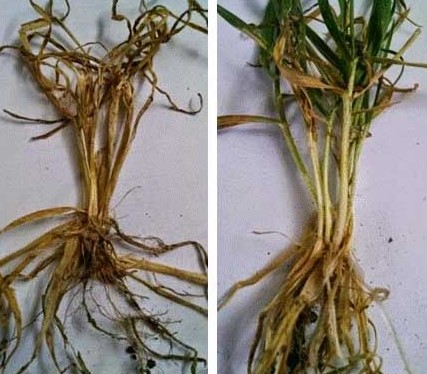By Romulo Lollato, Mary Knapp
The weather during the period of December 16, 2019 to January 17, 2020 brought some much needed moisture to the Kansas wheat crop, with some areas seeing a considerable amount of ice and snow. Precipitation totals ranged from about 0.12 inch in far northwest Kansas, to just over 5.5 inches in southeast Kansas (Fig. 1). The majority of the state received more than 0.5 inches of precipitation. The snowfall that accompanied some of these precipitation events can help protect the crop from extreme cold temperatures, although it may not bring much moisture (usually, one foot of snowfall translates into about 1 inch of moisture).
Figure 1. Cumulative precipitation for the period from December 16, 2019 to January 17, 2020. Maps by Weather Data Library, Kansas State University.
These storms were accompanied by relatively mild temperatures throughout the state, with mean temperatures ranging from ~27.2 to 41.4 degrees Fahrenheit so that the entire state had a positive departure from the normal mean temperature for the period (Figure 2).
Figure 2. Mean temperature (upper panel) and departure from the mean temperature (lower panel) for Kansas during period from December 16, 2019 to January 17, 2020. Maps from Kansas Weather Data Library, Kansas State University.
Ice formation
Ice storms occur when freezing rain falls for a long period of time, accumulating on roads, trees, and over the winter wheat crop. Typically, ice storms begin with snow which changes to sleet, and then to rain, which in turn freezes on contact, coating all exposed surfaces with a layer of ice that expands as the storm continues.
Is there possible ice damage to the wheat and alfalfa crops?
Most likely, no. For an established alfalfa stand or wheat crop to suffer damage from ice, previous research has shown that a minimum 10 to 40 days of ice surrounding the leaves is necessary. Ice generally damages plants by sealing leaves, stems, and buds from the surrounding air, creating an anaerobic environment. When ice surrounds the crown of wheat or alfalfa for long periods of time, it allows toxic metabolites resulting from this anaerobic environment (ethanol and carbon dioxide) to build up, preventing the natural gas exchange that occurs during respiration. In other words, it “suffocates” the plants. Still, for this suffocation to occur, a long period of ice-covered leaf surface is needed; thus, the crops in Kansas should not suffer from ice damage resulting from the recent storms. Overall, the recent precipitation events should be beneficial to supply moisture for both crops going into the spring.
What should you look for when assessing plant survival?
We should not expect any cold damage from the more recent storm, but a few extreme drops in temperature with very little snow cover may have happened in specific fields, which might result in some cold damage. It will not be possible to fully know whether winter cold has caused damage to the wheat or alfalfa crops approximately until spring green-up, when the crops are breaking winter dormancy. At that point, it is extremely important to go out and check the fields, preferably destructive sampling it, before investing any more money in the crop.
For wheat, producers should pull plants out of the ground, pull the leaves back to expose the crown and stems, and check for color. Brown color with shriveled, mushy stems indicate damage and possibly, winterkill (Figure 3). White stems and healthy-looking crown area, even when some slight injury is present (Figure 3), should not be of major concern.
Producers should check to determine plant survival, and shoot for anywhere from 20 to 30 healthy plants per square foot, depending on location within the state (20 plants for the western portion of the state, 30 plants for central and eastern portions). If the final healthy wheat stand is lower than those 20 to 30 plants per square foot (approximately 50% being a threshold for maintaining or terminating the crop), producers can try and compensate with additional N to enhance spring tillering. If stands are lower than about 10 plants in western Kansas, and 15 plants in central and eastern Kansas, producers could consider planting a spring crop as an alternative.

Figure 3. Comparison between a winter wheat plant that suffered winter injury, characterized by brown crown and srhiveler stems (left panel) and a plant that shows minor symptoms of cold damage (brown leaves) but overal white and healthy stems (right panel). Photos by Sandra Wick, K-State Extension agent in the Post Rock District.
For alfalfa, the procedure should be similar. Producers should use a spade to cut into the taproot and crown, and checking whether the color is a healthy whitish-beige, or a darker brown which would be an indicative of an ice-damaged crown. Additionally, producers should look for newly appeared green crown buds at ground level. A good goal to shoot for is approximately 30 vigorous tillers per square foot. If poorer stands are found, producers can consider a soil test to determine whether added nutrients are needed. Another option is to delay the first harvest to beyond the late bud stage, which would decrease the quality of the first cut but reserves for regrowth will be higher, most likely improving persistence of the stand.
Source : ksu.edu